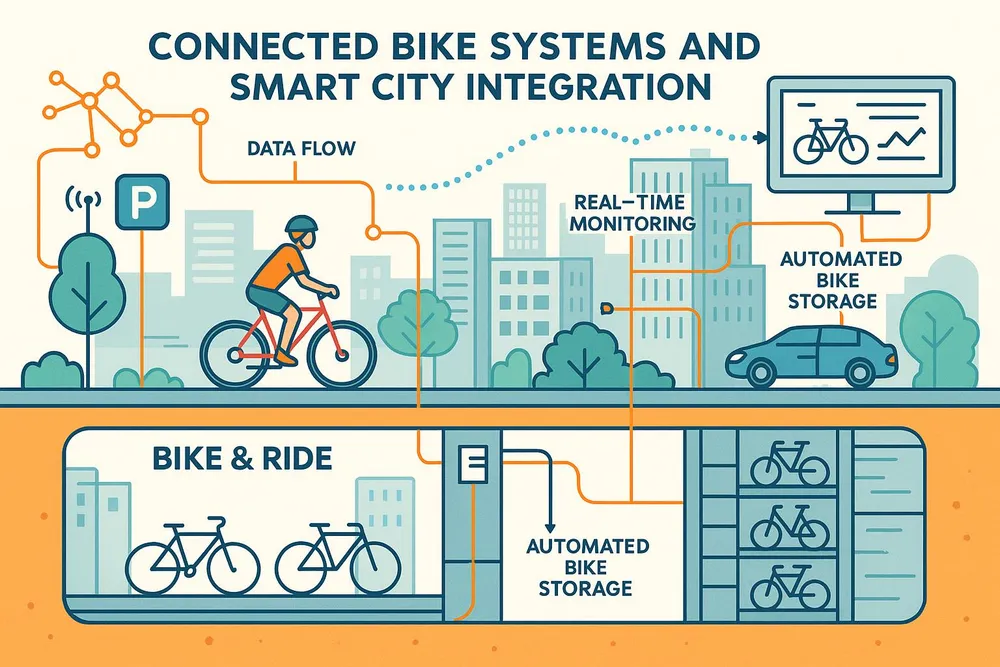The urban mobility landscape is experiencing a revolutionary transformation in 2025, with smart cycling infrastructure emerging as the cornerstone of sustainable transportation systems worldwide. Cities across the globe are implementing sophisticated connected bike systems that integrate seamlessly with existing transportation networks, creating intelligent cycling ecosystems that enhance safety, efficiency, and accessibility for riders of all levels. This technological revolution represents far more than simple bike lanes and traffic signals—it encompasses a comprehensive reimagining of how cycling infrastructure can leverage Internet of Things (IoT) technology, artificial intelligence, and real-time data analytics to create responsive, adaptive transportation networks that prioritize cyclist safety and convenience.
The convergence of smart city initiatives with cycling infrastructure development has created unprecedented opportunities for innovation in urban transportation. Modern smart cycling systems integrate multiple technologies including intelligent traffic management, real-time route optimization, predictive maintenance systems, and comprehensive safety monitoring that work together to create cycling environments that are not only safer and more efficient but also more attractive to potential cyclists who may have previously been deterred by safety concerns or infrastructure limitations.
The economic and environmental implications of smart cycling infrastructure extend far beyond immediate transportation benefits to encompass broader urban development objectives including reduced traffic congestion, improved air quality, enhanced public health outcomes, and more sustainable urban growth patterns. Cities implementing comprehensive smart cycling systems are reporting significant improvements in cycling participation rates, reduced accident rates, and measurable improvements in overall urban mobility efficiency that justify the substantial investments required for these advanced infrastructure systems.
The integration of smart cycling infrastructure with existing transportation networks creates synergistic effects that enhance the overall efficiency and effectiveness of urban mobility systems. Connected bike systems can communicate with public transit networks, ride-sharing services, and traffic management systems to provide seamless multimodal transportation options that make cycling a more attractive and practical choice for urban residents and commuters.

The Evolution of Cycling Infrastructure Technology
The development of smart cycling infrastructure represents a fundamental evolution from traditional passive infrastructure to active, responsive systems that can adapt to changing conditions and user needs in real-time. Traditional cycling infrastructure, while essential for basic safety and accessibility, has been largely static, providing fixed solutions that cannot respond to changing traffic patterns, weather conditions, or user demands. The emergence of smart infrastructure technologies has transformed this paradigm, creating dynamic systems that can monitor conditions continuously and adjust their operation to optimize safety, efficiency, and user experience.
The technological foundation of smart cycling infrastructure rests on the integration of multiple advanced systems including sensor networks, wireless communication protocols, data analytics platforms, and automated control systems. These technologies work together to create comprehensive monitoring and management capabilities that extend far beyond what traditional infrastructure can provide. Sensor networks embedded throughout cycling infrastructure can monitor traffic volumes, speed patterns, environmental conditions, and safety incidents in real-time, providing the data necessary for intelligent system responses and long-term planning optimization.
The wireless communication infrastructure that enables smart cycling systems has evolved dramatically in recent years, with the deployment of 5G networks, dedicated short-range communications (DSRC), and mesh networking protocols that ensure reliable connectivity even in challenging urban environments. These communication systems enable real-time data exchange between infrastructure components, mobile devices, and central management systems, creating comprehensive information networks that support both immediate operational needs and long-term strategic planning.
The artificial intelligence and machine learning algorithms that power smart cycling infrastructure systems have been developed specifically to address the unique challenges of cycling transportation, including the need to balance safety, efficiency, and accessibility across diverse user populations with varying skill levels and equipment capabilities. These systems can learn from historical usage patterns, predict future demand, and optimize infrastructure operation to provide the best possible experience for all users while maintaining safety as the primary priority.
The integration of smart cycling infrastructure with broader smart city initiatives creates opportunities for comprehensive urban optimization that extends beyond transportation to encompass energy management, environmental monitoring, and public safety systems. Smart cycling infrastructure can contribute data to city-wide analytics platforms that support evidence-based decision making for urban planning, resource allocation, and policy development that benefits all residents and visitors.
The standardization and interoperability requirements for smart cycling infrastructure have driven the development of open protocols and common standards that ensure compatibility between different vendors and systems while enabling cities to avoid vendor lock-in and maintain flexibility for future upgrades and expansions. These standards are crucial for ensuring that smart cycling infrastructure investments provide long-term value and can adapt to evolving technology and user needs.
Connected Traffic Management and Signal Systems
The integration of cycling infrastructure with intelligent traffic management systems represents one of the most significant advances in urban transportation technology, creating responsive traffic control systems that can optimize signal timing and traffic flow to prioritize cyclist safety and efficiency while maintaining overall traffic system performance. Connected traffic signals equipped with advanced sensors and communication capabilities can detect approaching cyclists, adjust signal timing to provide adequate crossing time, and coordinate with adjacent intersections to create green wave progressions that minimize stops and delays for cycling traffic.
The sensor technologies employed in connected traffic management systems include computer vision systems, radar sensors, inductive loop detectors, and wireless beacon systems that can accurately detect and classify different types of road users including cyclists, pedestrians, and various vehicle types. These sensors provide real-time data about traffic conditions that enable intelligent signal control systems to make optimal timing decisions based on current demand rather than fixed timing patterns that may not reflect actual usage patterns.
The artificial intelligence algorithms that control connected traffic systems have been specifically designed to balance the competing demands of different road users while prioritizing safety and efficiency for vulnerable road users including cyclists and pedestrians. These systems can learn from historical traffic patterns, predict future demand based on time of day, weather conditions, and special events, and adjust their operation to provide optimal service for all users while maintaining overall system performance.
The communication protocols that enable connected traffic management systems utilize both wired and wireless networks to ensure reliable data exchange between traffic signals, central control systems, and mobile devices carried by cyclists and other road users. Vehicle-to-infrastructure (V2I) and infrastructure-to-vehicle (I2V) communication protocols enable real-time information sharing that can provide cyclists with advance warning of signal changes, optimal routing suggestions, and safety alerts about potential hazards or conflicts.
The integration of connected traffic management systems with mobile applications and cycling computers provides cyclists with real-time information about traffic conditions, optimal routes, and signal timing that can enhance both safety and efficiency. These applications can provide turn-by-turn navigation that takes into account current traffic conditions, suggest alternative routes to avoid congestion or construction, and provide real-time updates about infrastructure status and availability.
The data analytics capabilities of connected traffic management systems provide valuable insights into cycling traffic patterns, infrastructure utilization, and safety performance that support evidence-based decision making for infrastructure planning and optimization. This data can identify high-demand corridors that may benefit from infrastructure improvements, detect safety issues that require attention, and measure the effectiveness of infrastructure investments in achieving their intended objectives.
The maintenance and reliability requirements for connected traffic management systems require robust design and redundant communication pathways to ensure continued operation even when individual components fail or communication networks experience disruptions. These systems must be designed to fail safely, maintaining basic traffic control functionality even when advanced features are unavailable, and provide clear indication of system status to both operators and users.
Smart Bike Parking and Storage Solutions
The development of intelligent bike parking and storage systems represents a crucial component of comprehensive smart cycling infrastructure, addressing one of the most significant barriers to cycling adoption in urban environments through the provision of secure, convenient, and accessible bike storage solutions that integrate seamlessly with broader transportation networks. Smart bike parking systems utilize advanced technologies including automated access control, real-time availability monitoring, and integrated payment systems to provide cyclists with reliable, secure storage options that encourage cycling participation and support multimodal transportation strategies.
The technological foundation of smart bike parking systems includes electronic access control systems, occupancy sensors, surveillance cameras, and wireless communication networks that work together to provide secure, monitored storage environments that protect valuable cycling equipment while providing convenient access for authorized users. These systems can be integrated with mobile applications that allow users to locate available parking spaces, reserve storage spots in advance, and access facilities using smartphone-based authentication systems.
The automated access control systems employed in smart bike parking facilities utilize multiple authentication methods including RFID cards, smartphone applications, biometric scanners, and traditional key systems to provide flexible access options that accommodate different user preferences and security requirements. These systems maintain detailed logs of facility usage that support both security monitoring and usage analytics that inform facility planning and optimization decisions.
The real-time monitoring capabilities of smart bike parking systems provide users with current information about facility availability, enabling them to plan their trips more effectively and avoid the frustration of arriving at full facilities. This information can be integrated with navigation applications and cycling route planning systems to provide comprehensive trip planning that includes both routing and parking considerations.
The integration of smart bike parking systems with public transit networks creates seamless bike-and-ride opportunities that enable cyclists to combine cycling with public transportation for longer trips or when weather conditions make cycling impractical. These integrated systems can provide coordinated scheduling information, transfer discounts, and unified payment systems that make multimodal transportation more convenient and attractive.
The security features of smart bike parking systems include comprehensive surveillance systems, tamper-resistant storage units, and immediate alert systems that notify both users and security personnel of any unauthorized access attempts or security breaches. These systems provide levels of security that far exceed traditional bike parking options, addressing one of the primary concerns that prevent people from cycling in urban environments.
The maintenance and operational requirements for smart bike parking systems include regular cleaning and maintenance of mechanical components, software updates for electronic systems, and ongoing monitoring of system performance to ensure reliable operation. These systems require dedicated operational support to maintain their effectiveness and user satisfaction, but the benefits in terms of increased cycling participation and reduced bike theft typically justify these operational costs.
IoT Integration and Real-Time Data Systems
The Internet of Things (IoT) integration in smart cycling infrastructure creates comprehensive data collection and analysis capabilities that enable real-time monitoring, predictive maintenance, and evidence-based optimization of cycling systems across entire urban networks. IoT sensors embedded throughout cycling infrastructure continuously collect data about usage patterns, environmental conditions, infrastructure performance, and safety incidents that provide the foundation for intelligent system management and long-term strategic planning.
The sensor networks that form the backbone of IoT-enabled cycling infrastructure include traffic counters, speed sensors, environmental monitors, pavement condition sensors, and safety detection systems that work together to provide comprehensive situational awareness about cycling infrastructure performance and utilization. These sensors utilize low-power wireless communication protocols that enable long-term deployment without requiring frequent battery replacement or extensive wiring infrastructure.
The data analytics platforms that process IoT sensor data utilize machine learning algorithms and statistical analysis techniques to identify patterns, predict future conditions, and generate actionable insights that support both operational decision making and strategic planning. These platforms can detect emerging maintenance needs before they become critical, identify safety hazards that require immediate attention, and optimize infrastructure operation to provide the best possible user experience.
The real-time data visualization and reporting systems that present IoT data to infrastructure managers and city planners provide intuitive interfaces that make complex data accessible and actionable. These systems can generate automated alerts when conditions require immediate attention, provide comprehensive dashboards that show system performance across entire networks, and generate detailed reports that support budget planning and infrastructure investment decisions.
The integration of IoT cycling infrastructure data with broader smart city data platforms creates opportunities for comprehensive urban optimization that considers cycling infrastructure as part of larger transportation, environmental, and public safety systems. This integration enables coordinated responses to changing conditions, comprehensive impact assessment of infrastructure investments, and evidence-based policy development that considers the full range of urban systems and their interactions.




